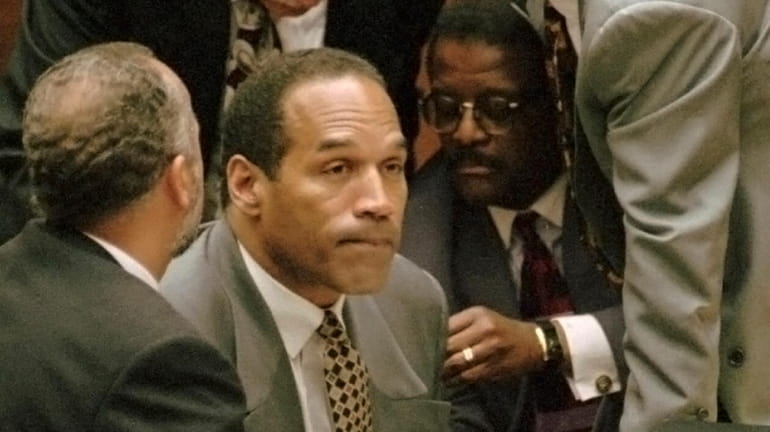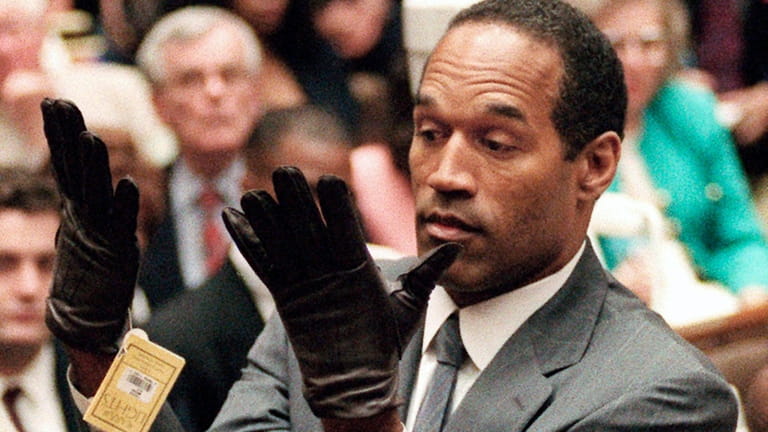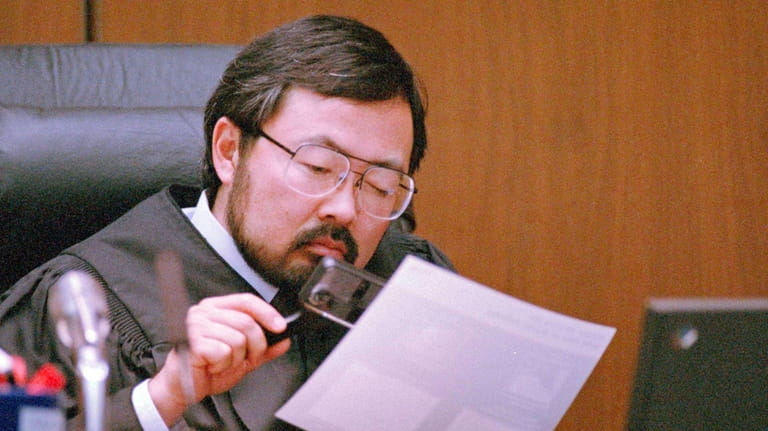O.J. Simpson's fall from grace a perfect tabloid storm

O.J. Simpson is surrounded by his defense team during his 1995 murder trial in the deaths of his ex-wife and her friend. Credit: AP/Myung J. Chun
Nearly 30 years ago, the legal and entertainment worlds fused in the most high-profile union to date of celebrity, courtroom drama and breaking news.
The “Trial of the Century” of football icon, TV pitchman, Hollywood star and accused double murderer O.J. Simpson, who died Wednesday, would forever alter how Americans ingest popular culture, while shaping the views of an entire generation about how the courts operate — at least for the fabulously wealthy.
From “The Tonight Show's” “Dancing Itos'" (a parody of Simpson trial Judge Lance Ito) to bombastic lawyer Jackie Chiles (Phil Morris' caricature of Johnnie Cochran) on "Seinfeld," the Simpson case swept every corner of popular culture and television.
But the most profound impact was on TV news, then dominated by the three major networks and CNN. As part of cost-saving measures, major news organizations had redirected resources from foreign coverage to domestic stories.
On the night of June 17, 1994, a huge one fell into their laps.
Wall-to-wall coverage
“In terms of pure, condensed drama, I have never covered a story that compared to this one,” veteran ABC News correspondent Judy Muller told Newsday shortly after the infamous white Ford Bronco chase that captivated some 95 million viewers.
Wall-to-wall coverage followed, and with it, growing criticism.

An iconic moment during O.J. Simpson's murder trial when he tried on gloves for the jury that were similar to a bloody one found at the scene where his ex-wife and friend were stabbed to death. Credit: AP/Vince Bucci
The late Fred Friendly, former president of CBS News, told Newsday at the time: "We can show O.J. Simpson in his white car, but nothing about Rwanda. People in foreign countries must look at that and think that we're crazy. My own theory is that TV makes so much [money] doing its worst that it can't afford to do its best.”
So-called “OJTV” was born and there was no going back.
The most famous trial in American history began on Jan. 24, 1995, attracting thousands of reporters, anchors and crews, who would decamp for nearly a year in an elaborate “Media City” across from the downtown Los Angeles criminal courts building — each feeding daily, and soon hourly, reports.
Limited coverage unworkable
The networks floated ideas at limiting coverage, if only to salvage their already troubled soap opera empires, but soon realized they were unworkable.
Every outlet, tabloid show and cable network, from ESPN to CourtTV, CNN and E!, covered the trial, with many attracting their largest audiences ever.
Robert Jordan, a veteran anchor for CBS News and Chicago's WGN, told Newsday on Thursday the coverage was justified “because the story ticked all the boxes for what makes a breaking news story important, and ticked off a few more after that. And once a story like this begins, it starts to gallop, then takes on a life of its own.”
It wasn't just TV that was forever altered.

Judge Lance Ito became a punchline on late-night talk shows. Credit: AP/Mark J. Terrill
Richard Klein, a criminal law professor at Touro Law School, said the Simpson trial introduced millions of Americans to the concept of jury nullification — when a jury decides not to convict, even though it was shown beyond a reasonable doubt that the defendant committed the crime.
Fred Klein, who teaches criminal procedure and runs a prosecution clinic at Hofstra University, said for many young Americans, the trial was their first window into the operations of the criminal justice system — even if that view was stilted by a defendant with a “dream team” of high-priced attorneys.
“It's good for the public to become aware of how the criminal justice system works — good, bad and indifferent,” Klein said. “But it also gave a misleading impression of how the system works because 99.99% of people charged with a crime don't have F Lee Bailey, Alan Dershowitz and Johnnie Cochran representing them.”
Watershed moment
By the time the verdict was read on Oct. 3, 1995, a watershed moment had arrived — the most-watched breaking news event in history with an estimated audience of 150 million.
Jordan recalled covering the verdict in his Chicago Hyde Park neighborhood and seeing a crowd of predominantly Black residents cheering Simpson's acquittal.
“And then I scanned the crowd and saw disbelief on some faces and many of those were white,” said Jordan, who is Black. “I realized this case had a deep underlying influence on how we all align ourselves.”
Muller, now a professor emerita of journalism at the University of Southern California, said while some dismissed the case as “sensational” it also held up a mirror to the differences between Black and white Americans.
For millions of Black Americans, she said, “I think there was really a feeling of 'finally, one for our side.' That to me was always the important tell on this story — that we could finally see this huge division, racially, in this country, in how justice is served, and how it is observed.”

Updated now Newsday travel writer Scott Vogel took the ferry over to Block Island for a weekend of fun.

Updated now Newsday travel writer Scott Vogel took the ferry over to Block Island for a weekend of fun.
